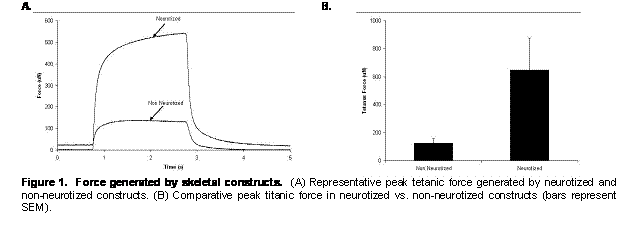McCormick Place, Lakeside Center
Sunday, September 25, 2005
9:00 AM - 5:00 PM
McCormick Place, Lakeside Center
Monday, September 26, 2005
9:00 AM - 5:00 PM
McCormick Place, Lakeside Center
Tuesday, September 27, 2005
9:00 AM - 5:00 PM
McCormick Place, Lakeside Center
Wednesday, September 28, 2005
9:00 AM - 5:00 PM
8201
Neurotization of In Vivo Tissue Engineered Contractile, Vascularized, 3- Dimensional Skeletal Muscle Constructs
Objective: Previously, we developed a model of producing in vivo tissue engineered, contractile 3-dimensional skeletal constructs with the incorporation of an intrinsic blood supply. It is well known that neural signals direct the maturation and phenotypic expression of developing muscle. Therefore, we hypothesized that neurotization of these constructs during their development would result in an improvement in their force-generating capability, and that neuromuscular junctions would form and allow indirect stimulation of the muscle construct via the nerve.
Methods: Skeletal myocytes were isolated from adult F344 rat soleus muscles, and were seeded into silicone ‘chambers' filled with fibrin gel, at six million myocytes per chamber. Eight chambers were bilaterally implanted in the groin area of four rats. On one side, chambers were implanted around the femoral vessels to provide an intrinsic blood supply to the developing construct. On the contralateral side, the femoral nerve was transected and was transposed into the chamber. The formed constructs were removed after four weeks, and mechanical force testing was performed via direct and indirect stimulation.
Results: After 4 weeks, the chambers found to be filled with newly-formed ‘flaps' of tissue, supported by robust angiogenesis from the femoral artery and vein. In vitro contractility of the harvested constructs was evaluated. Using field (direct) stimulation, the maximum tetanic contraction for neurotized constructs was found to be significantly higher than that for control constructs in all four animals (example, Figure 1A). We found a five fold increase in the average maximum force generated by the neurotized constructs in all four animals (Fig.1B). The average peak isometric tetanic force generated by the neurotized constructs was 649 μN (N=4) as compared to 124 μN (N=4) by the non-neurotized constructs. In addition, stimulation of the neurotized constructs via their nerves (indirect) resulted in force generation, which was halted by the addition of curare, a potent blocker of neuromuscular junctions.
Conclusion: Neurotization of developing tissue engineered skeletal muscle constructs results in a significant improvement in force generation, supporting the principle that phenotypic maturity is influenced by neural input. This study also demonstrates the formation of neruromuscular connections in our in vivo model. Further work will focus on characterization of the neuromuscular junction and specific phenotypic changes that are influenced by neural input.
View Synopsis (.doc format, 198.0 kb)

